




Key Takeaways
- A sales page is a single webpage created to convert visitors into students for your course.
- An effective sales page for online courses highlights the course’s unique benefits and appeals directly to potential learners.
- It guides visitors through the course’s advantages and core content, motivating them to enroll.
Introduction
A sales page is a dedicated webpage designed to turn interest in an online course into actual sign-ups. Unlike a general landing page, a sales page is focused on showcasing a course’s value, giving potential students a clear understanding of what they’ll gain.
This is especially important for online courses, where learners need specific details to decide if the course matches their goals. A well-designed sales page is a crucial tool in converting curiosity into enrollment.
Importance of a Sales Page for an Online Course
A well-crafted sales page is essential for converting visitors into students for an online course. It goes beyond simply describing the course—it emphasizes the unique value, benefits, and outcomes that potential students can expect.
A sales page builds trust, answers common questions, and addresses any hesitations visitors may have, making it easier for them to decide to enroll.
A sales page effectively communicates why the course is worth its time and investment by highlighting key aspects like course content, learning outcomes, and student testimonials.
Key Benefits of a Sales Page
- Increased Conversion Rates: Businesses using dedicated sales pages experience an average conversion rate of 13%, higher than the general average of 11%.
- Enhanced User Engagement: Including videos on sales pages can increase user engagement by up to 80%, providing potential students with a preview of the course experience.
- Clarity on Course Benefits: Outlining learning outcomes and course benefits clearly can boost conversions by as much as 20%.
- Customer Testimonials and Social Proof: Displaying testimonials and reviews can increase conversions by 12.5%, as they validate the course's value and reassure new students.
- Direct Path to Enrollment: A single, prominent call-to-action (CTA) on a sales page can increase conversion rates by 25%, streamlining potential students' decision-making process.
Examples of Successful Sales Pages in Online Courses
- MasterClass: Utilizes visually compelling sales pages with high-quality images, trailers, and quotes from well-known instructors to create excitement and drive enrollments.
- Coursera: Emphasizes tangible learning outcomes, such as specific skills and certifications, and uses data from course graduates to provide social proof, enhancing credibility.
- Udemy: Each sales page includes a mix of reviews, ratings, and course previews, combining testimonials with detailed course descriptions to build trust and increase conversions.
In summary, a sales page is invaluable for online course providers. By incorporating persuasive elements like testimonials, clear outcomes, and engaging media, sales pages become potent tools for converting potential students into committed learners.
3 Types of Sales Pages for Online Courses
When creating a sales page for an online course, selecting the appropriate format is crucial to engage your target audience and drive conversions effectively.
Here are three common types of sales pages, each tailored to different course offerings and audience preferences:
1. Long-Form Sales Page
A long-form sales page provides an in-depth course overview, making it ideal for high-priced or comprehensive programs. This format includes detailed sections covering course benefits, learning outcomes, instructor credentials, testimonials, and case studies.
It caters to potential students who require extensive information before purchasing.
Example: The "Quantum Growth" course by Sabri Suby utilizes a long-form sales page featuring a compelling headline, an attention-grabbing video, and a bold call to action. The page employs the Problem-Agitation-Solution (PAS) formula, effectively addressing potential students' pain points and presenting the course as the solution.
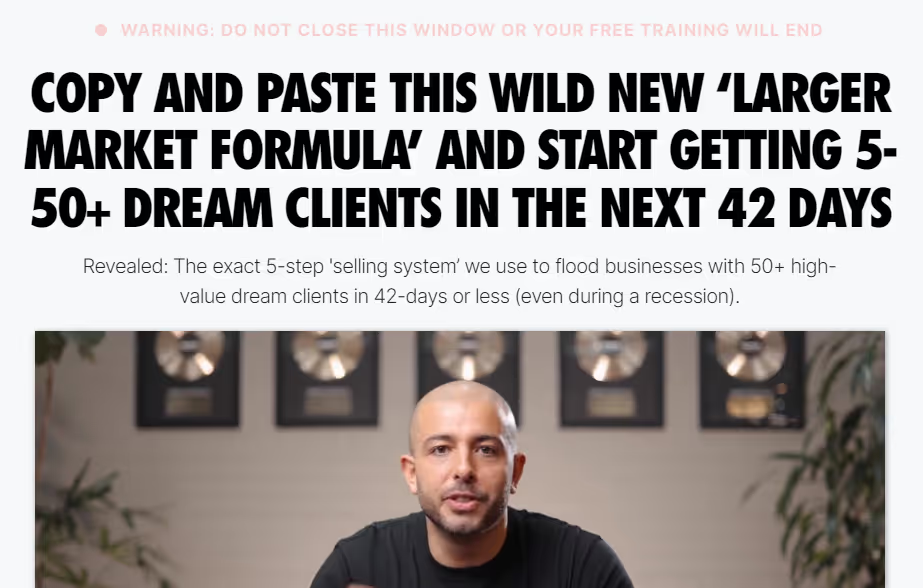
2. Short-Form Sales Page
Short-form sales pages are concise and focus on quickly capturing visitors' interest. They are suitable for lower-cost courses, short-term programs, or audiences who prefer brief content.
These pages highlight key points such as course objectives, main benefits, and a clear call-to-action, providing enough information to prompt a quick signup.
Example: The "Graphic Design Mastery" course by Lindsay Marsh employs a short-form sales page that includes a clear and compelling headline, a brief course description, and a straightforward call-to-action. The simplicity and clarity of the page make it easy for potential students to understand the course offering and enroll promptly.
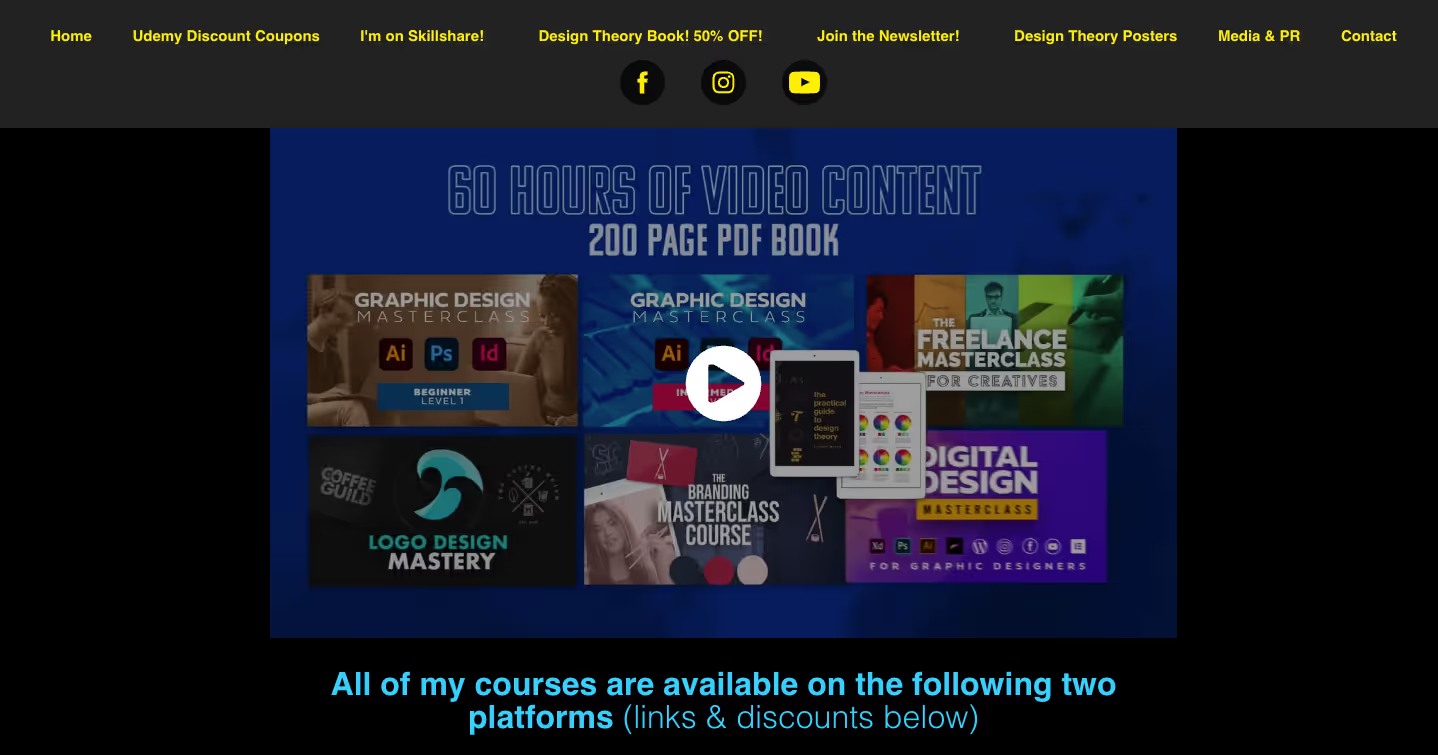
3. Video Sales Page
A sales page relies on video as the primary medium to convey the course’s value. This format is effective for audiences who prefer visual content and helps create a personal connection by allowing potential students to "meet" the instructor.
Video sales pages typically include an introductory video that explains the course, its benefits, and outcomes, supported by minimal text to guide viewers toward enrollment.
Example: The "Copy School" program by Joanna Wiebe features a sales page with a short but detailed video providing an excellent overview of the course. The video, combined with clear and compelling copy, effectively communicates the course's value and encourages potential students to enroll.
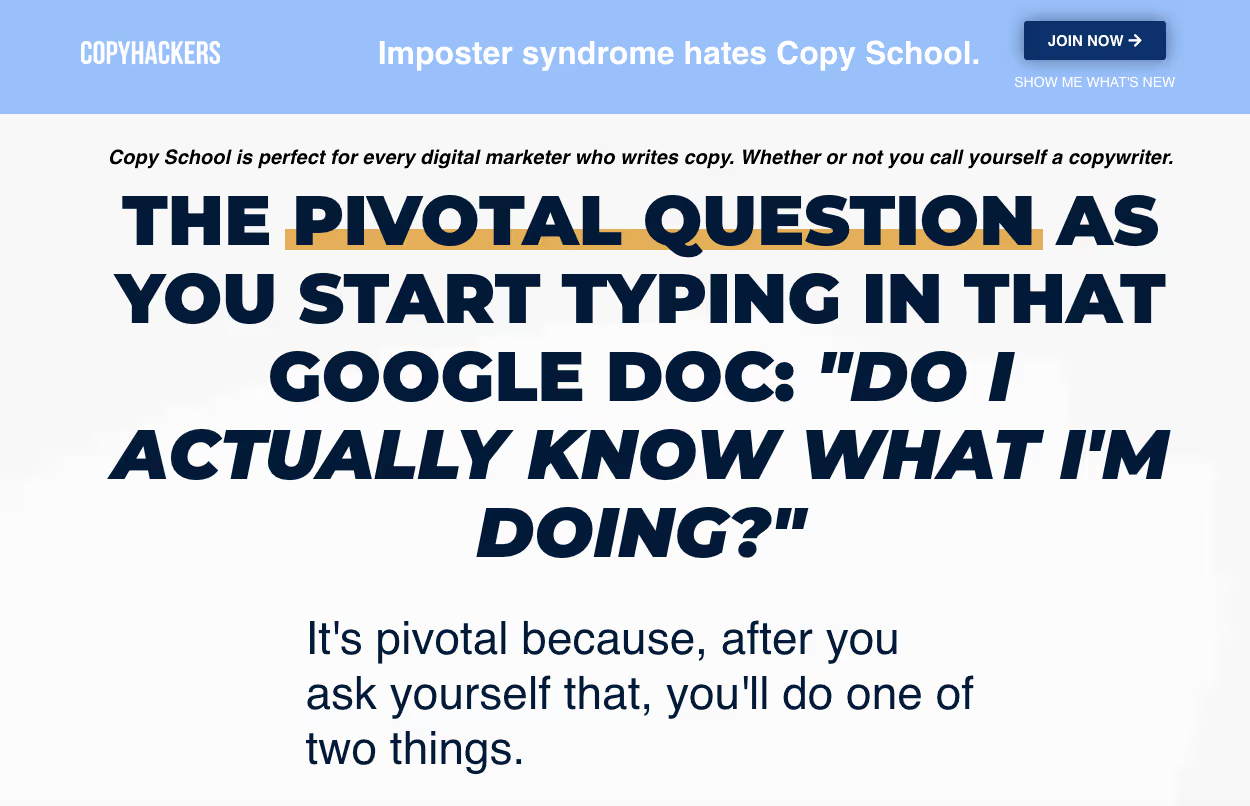
Each type of sales page serves a distinct purpose and can be customized to meet the specific needs of your online course and target audience. Selecting the right format can significantly enhance the effectiveness of your sales page and lead to higher conversion rates.
What to Include on Your Online Course Sales Page: 7 Essential Elements
1. Start with a Headline and Hero Section
Imagine someone lands on your page; your headline is the first thing they’ll read. It’s like a storefront sign—they might just leave if it doesn’t grab their attention. Think of a headline that’s short, clear, and highlights the main benefit of your course. Underneath, add a subheading or tagline to give a bit more context.
Example: Let’s say your course is about digital marketing. A headline like "Master Digital Marketing: From Basics to Advanced Strategies" gets to the point. Students will start from the basics and build advanced skills. Add a subheading like "Learn from industry experts and develop skills to drive real business growth."
This way, someone looking to grow in digital marketing can immediately see that your course offers real, career-focused skills.
Why it Matters: This section draws people in. They’ll scroll down to learn more about what’s next if the headline speaks to them.
2. Craft a Strong Course Description
Consider the course description a friendly explanation of what students will get from your course. This isn’t the place for long paragraphs or lots of jargon—just a few sentences that tell them precisely what they’ll learn and why it matters. Be specific! Instead of saying, “Learn Photoshop,” you could say, “In this course, you’ll learn to create, edit, and enhance digital images using Adobe Photoshop, from basic retouching to advanced techniques.”
Example: "In this digital marketing course, you'll learn everything from creating targeted ad campaigns to analyzing social media metrics. By the end, you’ll be ready to apply these skills to real-world business challenges."
This way, potential students can see exactly what they’ll get and can start picturing how it will help them.
Why it Matters: A clear description directly addresses what students want: “Will this help me? Will it be worth my time?”
3. Add Case Studies and Testimonials
People trust other people. You show that others have benefited from your course when you add testimonials or case studies. You don’t need tons of testimonials—just a few real examples. If you don’t have testimonials, consider sharing a story of someone you helped with this information, even if it wasn’t in a formal course.
Example: A student testimonial might say, “After this coding boot camp, I got a junior developer role at a startup. The hands-on projects made it feel real, and the career advice was invaluable.”
Why it Matters: Think of testimonials as a recommendation from a friend. When potential students see that others have succeeded, they’re more likely to feel your course is trustworthy and effective.
4. Use a Clear Call to Action (CTA)
Once people are interested, they need a nudge to sign up. Your “Call to Action” (CTA) comes in here. It should be short and action-oriented, like “Join Now” or “Start Learning Today.” Place a CTA button at the end of each major section so that when people feel ready to take action, they have a button.
Example: “Ready to transform your photography skills? Join today and start creating stunning images.”
Adding this after your course description reminds visitors of the course’s value and makes it easy for them to sign up.
Why it Matters: A clear, well-placed CTA helps people decide without overthinking. If they’re ready to sign up, they shouldn’t have to search for a button to click.
5. Make the CTA Button Stand Out
You’ve already put CTAs throughout your page, but your CTA button itself is important, too. Use a color contrasting with your page's rest and make the text straightforward. Phrases like “Get Instant Access” or “Enroll Now” work well here. Avoid vague words—keep it clear and simple.
Example: A bright color button at the top of the page that says “Get Started” draws the eye. It should be easy for them to click and move forward when they're interested.
Why it Matters: The button design may seem small but plays a big role. A bright, easy-to-read button encourages people to click without overthink the next step.
6. Introduce the Instructor (That’s You!)
Adding a short bio builds a personal connection and trust. People like to know who they’re learning from, so share a few lines about yourself, including your expertise and experience related to the course topic. If you have a photo or a quick video of yourself, add it here—it humanizes the page and makes you approachable.
Example: “This course is taught by Dr. Jane Smith, who holds a Ph.D. in Psychology and has over 20 years of experience in behavioral science. Jane’s teaching approach combines theory with practical examples, so you’ll feel ready to apply your knowledge immediately.”
This lets students know they’ll be learning from someone experienced and passionate.
Why it Matters: A bio gives potential students confidence that you’re knowledgeable and trustworthy, making them feel more comfortable enrolling.
7. Include an FAQ Section
Think about common questions people might have before enrolling. For instance, “Do I need any prior knowledge?” or “What’s the course format?” Answering these questions upfront saves them from having to ask and keeps them focused on the page.
Example: “Do I need experience in digital marketing to take this course? No, we start with the basics, so it’s great for beginners and those with some experience.”
Why it Matters: An FAQ section helps clarify details and remove any last doubts, making them more confident and enrolling.
Setting up each section builds an informative, trustworthy, and encouraging page for potential students.
Frameworks that can help you optimize your sales page
1. AIDA Framework for Structure
One of the most popular frameworks for building a sales page is AIDA (Attention, Interest, Desire, Action). Each section of your sales page should guide visitors through these four stages:
- Attention: Capture attention with a powerful headline and hero section.
- Interest: Build interest with a clear course description.
- Desire: Increase desire by showcasing testimonials, instructor bio, and case studies.
- Action: Encourage them to act with a strong call to action and a well-designed CTA button.
Using AIDA ensures your page flows in a way that makes people feel naturally guided from initial curiosity to enrollment.
2. StoryBrand Framework for Messaging
The StoryBrand framework by Donald Miller focuses on clear messaging by positioning the potential student as the hero and your course as the solution. Here’s how to use it for your page:
- Identify their problem: What challenge does your course help them overcome? Make this clear in the headline or hero section.
- Offer the solution: Explain how your course solves this problem through your course description.
- Show success: Highlight success stories through testimonials and case studies, giving them a vision of what they could achieve.
- Guide them to action: Use direct CTAs like “Join Now” or “Start Learning Today.”
This framework keeps your messaging focused on student needs, making it easy for them to see the course’s value.
3. Techniques for Each Section
Headline and Hero Section: The “Benefit-Driven” Technique
When crafting your headline, focus on benefits over features. Instead of just stating your course, highlight what it does for the student. The main question is, “What’s in it for me?” This technique works best with headlines that show transformation, growth, or success.
Technique Example:
- Headline: “Transform Your Marketing Skills: Build Campaigns that Drive Results”
- Subheading: “Guided by industry experts, this course equips you with the skills to make an impact.”
Implementation Tips:
- Use tools like CoSchedule’s Headline Analyzer to refine your headline.
- Test different variations to find the headline that resonates most.
Course Description: The “So That” Technique
Use the “So That” technique to emphasize the benefits of your course description. After each skill or feature you mention, add “so that…” to clarify how it benefits the student.
Technique Example:
- “You’ll learn to use data analytics in digital marketing so that you can make smarter business decisions and see real results.”
Implementation Tips:
- Limit jargon and keep sentences short for clarity.
- Run your description through readability tools like Grammarly to keep the language simple and accessible.
Case Studies and Testimonials: The “Before and After” Technique
Testimonials are most effective when they show a transformation. Structure them to show where the student was before the course and where they are after. This “before and after” technique helps potential students visualize their success.
Technique Example:
- Before: “I felt lost when it came to starting a career in digital marketing.”
- After: “After taking this course, I landed my first job as a social media manager, confident and ready to grow.”
Implementation Tips:
- Use a testimonial collection tool like Delighted to ask past students specific questions that encourage this “before and after” format.
- Ask beta testers or early users to share their feedback if you don't have testimonials.
Clear Call to Action (CTA): The “Action-Oriented Language” Technique
For your CTAs, use action-oriented language that encourages immediate response. Phrases like “Join Now” or “Get Started Today” imply that action is easy and achievable.
Technique Example:
- “Get Instant Access to Expert-Led Classes”
- “Join the Community and Start Learning Now”
Implementation Tips:
- Place CTAs at the end of every major section to give visitors multiple chances to act.
- Use heat mapping tools like Hotjar to see where people click on your page and adjust CTA placement.
CTA Button Design: The “Contrast and Clarity” Technique
The CTA button should be visually distinct and easy to read. Use a contrasting color and simple language. The contrast helps the button stand out, while clarity ensures there’s no doubt about what happens next.
Technique Example:
- Button Text: “Enroll Now” or “Get Instant Access”
- Color: Choose a color that contrasts with your page background but aligns with your brand (e.g., if your page background is white, a bright green or orange button would stand out).
Implementation Tips:
- Use A/B testing tools like Google Optimize to try different button colors and wording.
- Check accessibility with tools like WebAIM to ensure the color contrast meets accessibility standards.
Instructor Bio: The “Expertise and Relatability” Technique
Your instructor bio should position you as an expert while also being relatable. Focus on your qualifications and share some of your personality or journey to create a connection.
Technique Example:
- “Dr. Jane Smith, Ph.D., is an experienced psychologist who has spent 20 years helping students master behavioral science. She believes in making complex topics simple, with a practical approach that brings theory to life.”
Implementation Tips:
- Include a photo or video to make the bio feel more personal.
- Keep the language casual, avoiding overly technical jargon.
FAQ Section: The “Common Concerns” Technique
Your FAQ should address students' most common questions or concerns before enrolling. Consider the specific details students might need, like prerequisites, course format, or refund policies.
Technique Example:
- Question: “Do I need experience to join this course?”
- Answer: “No, this course is designed for beginners. We start from the basics and build up, so anyone can join.”
Implementation Tips:
- Use tools like Typeform or Google Forms to collect questions from visitors or early users to ensure you address the right concerns.
- Keep responses concise and clear for easy reading.
Additional Tips for Implementation
- Heatmaps & Analytics: Tools like Hotjar or Google Analytics help you understand how people navigate your page. This can reveal if certain sections need more emphasis or if CTAs need repositioning.
- A/B Testing: Try A/B testing elements like the headline, CTA language, or button color using tools like Optimizely or Google Optimize. This helps you see which versions are most effective.
- Visual Hierarchy: Make sure the design of your page uses a visual hierarchy (e.g., larger headlines, bullet points, whitespace) to guide visitors through the content smoothly.
How to Create a Sales Page for Online Courses
Creating a sales page for your online course requires a structured approach to ensure every element is designed to attract, engage, and convert visitors. Here’s a comprehensive step-by-step guide to building a high-converting sales page for your course. If you’re using our page builder, we’ll show how each step can be easily accomplished with its features.
Step 1: Choose a Template or Start from Scratch
Start by selecting a template optimized for course sales, which typically includes sections for headlines, course descriptions, testimonials, and CTAs. Templates save time and provide a professional design structure, though starting from scratch is ideal if you want a fully customized layout.
Example: In our page builder, choose from “Online Course Sales,” “Education Landing Page,” or “Course Conversion” templates. Each offers pre-built sections for easy customization.
Step 2: Craft a Compelling Headline and Hero Section
The headline is the first element visitors see and should convey the course’s main benefit. Make it specific and actionable, highlighting what students will achieve.
Headline Tips:
- Focus on results (e.g., “Become a Certified Data Scientist in 10 Weeks”).
- Make it relatable by addressing the target audience directly.
- Use strong, direct language, and pair it with a descriptive subheadline.
Example: “Start Your UX Design Career: Master Key Skills and Build a Portfolio in 8 Weeks.” Below the headline, add a brief subheading like “Learn from industry experts and gain hands-on experience in design.”
Step 3: Write a Clear and Persuasive Course Description
The course description is where visitors learn what they’ll gain. Describe the course structure, key topics, and specific skills students will acquire.
Structure Tips:
- Use bullet points to outline the modules or lessons.
- Include details on course duration, format (e.g., video lectures, quizzes), and access (e.g., lifetime or limited).
- Emphasize the benefits or transformations students can expect.
Example: “In this 12-module course, you’ll cover key topics, including JavaScript fundamentals, advanced CSS techniques, and responsive design. Perfect for beginners aiming to create professional websites.”
Step 4: Add Social Proof with Case Studies or Testimonials
Social proof builds trust and reassures visitors about the course’s value. If you have testimonials, use direct quotes from past students or include short case studies showing how the course helped them achieve real-world results.
Best Practices:
- Include student photos, if possible, which adds authenticity.
- Use specific testimonials with metrics (e.g., “I landed a job in software development within 3 months after completing this course.”).
- Consider video testimonials, which can increase engagement.
Example: “After taking this course, I transitioned to a senior analyst role, thanks to the advanced Excel skills I gained. The course made complex concepts easy to understand.” – John D., Finance Professional.
Step 5: Insert Clear Call-to-Action (CTA) Buttons
A CTA guides visitors to enroll. Place CTA buttons strategically throughout the page, especially after high-impact sections like the course description and testimonials. Use action-oriented phrases and make the button color distinct to draw attention.
CTA Tips:
- Text should be simple and direct (e.g., “Enroll Now,” “Start Today”).
- Position CTAs after each major section to give users multiple opportunities to act.
- Use hover effects or animations to make the button stand out.
Example: After the course description, place a button with text like “Enroll Now and Start Learning.” A contrasting color like orange or green works well against a neutral background.
Step 6: Design an Eye-Catching CTA Button
Your CTA button design is key to increasing clicks. Use a color contrasting with the background, and make it large enough to stand out without overwhelming the page. Include small icons, such as a lock for secure checkout or an “Instant Access” checkmark to add reassurance.
CTA Button Design Tips:
- Keep the text short and use verbs like “Join,” “Start,” or “Access.”
- Test different colors to see which works best with your overall design.
- Ensure it’s mobile-friendly with a large enough tap area.
Example: A CTA button with text like “Get Instant Access” in bright blue or green and an arrow icon can draw the user’s eye and prompt action.
Step 7: Add a Detailed Instructor Bio
Introduce the course instructor with a bio that covers their qualifications, experience, and teaching style. This section builds trust by showing students who they’ll be learning from, which can be a deciding factor in their enrollment.
Instructor Bio Tips:
- Include relevant credentials or awards.
- Add a professional, friendly photo.
- If possible, embed a short introductory video where the instructor speaks directly to potential students.
Example: “Meet Sarah Johnson, a certified nutritionist with over 10 years of experience. Sarah has helped hundreds of clients achieve their health goals, and her expertise has been featured in major publications.”
Step 8: Address Common Questions in an FAQ Section
Answer frequently asked questions about the course to reduce any barriers to enrollment. Address details like prerequisites, duration, refund policies, and certification. Use collapsible questions for a cleaner, organized look.
FAQ Tips:
- Keep answers brief and to the point.
- Group questions by category if there are many (e.g., “Course Details,” “Payment Options”).
- Use simple language to ensure clarity.
Example FAQs:
- “How long will I have access to the course?”
- “Can I get a refund if I’m not satisfied?”
- “Do I need any prior knowledge to enroll?”
Step 9: Add Visuals and Interactive Elements (Optional)
Visuals and interactive content can increase engagement. Adding video previews, progress bars, or graphics illustrating the course content can make the page more appealing.
Tips:
- Use video snippets of the course material.
- Add icons or badges for certifications or partner logos.
- Include a sample lesson or interactive quiz for students to understand the course.
Example: Add a “Preview Course” button with a short video or an interactive progress tracker to show course completion steps.
Step 10: Preview, Test, and Publish
Before publishing, preview the page on desktop and mobile to ensure it’s responsive. Test each CTA button, check formatting, and look for typos. Once satisfied, publish and start promoting the page to attract students.
By following these steps, you can create a high-converting sales page that showcases your course’s value and encourages visitors to enroll. Each element on the page serves a specific purpose, making it easier for potential students to feel confident and excited about joining your course.
If you’re using our page builder, these features help create an engaging, effective sales page tailored to your online course.
Examples of online course sales pages
Looking at successful sales pages can provide valuable insights for designing your own. Here are some standout examples, each demonstrating key elements that contribute to a high-converting course sales page.
1. The Copy Cure by Marie Forleo
Overview: "The Copy Cure" by Marie Forleo is a course focused on improving copywriting skills. The sales page is engaging informative, and showcases the course’s unique value.

Key Elements:
- Compelling Headline: “Write Copy That Converts & Sells” immediately communicates the primary benefit.
- Engaging Video: A high-quality introductory video featuring Marie Forleo adds a personal touch.
- Clear Course Description: Detailed information about the course, including modules and expected outcomes.
- Testimonials: Social proof from past students, enhancing credibility.
- Strong CTA: “Enroll Now” buttons are prominent and encourage immediate action.
Why It Works: Clear messaging, engaging visuals, and social proof create an effective and persuasive sales page.
2. MARKETING DIRECTOR COURSE by Seth Godin
Overview: Seth Godin’s "MARKETING DIRECTOR COURSE" provides in-depth training. The sales page is straightforward, focusing on course benefits and learning outcomes.

Key Elements:
- Direct Headline: “Learn to See the World Differently” captures attention and curiosity.
- Course Details: Clear information on course structure, duration, and student expectations.
- Instructor Bio: Highlights Seth Godin’s expertise in building trust.
- Community Emphasis: Highlights the course’s interactive community aspect, adding value.
- Clear CTA: Easily accessible “Enroll Now” buttons.
Why It Works: The page leverages Seth Godin’s authority and emphasizes the unique community experience, appealing to prospective students.
3. Digital Course Academy by Amy Porterfield
Overview: Amy Porterfield’s "Digital Course Academy" teaches students how to create and sell online courses. This sales page addresses common objections and provides in-depth information to guide potential students.
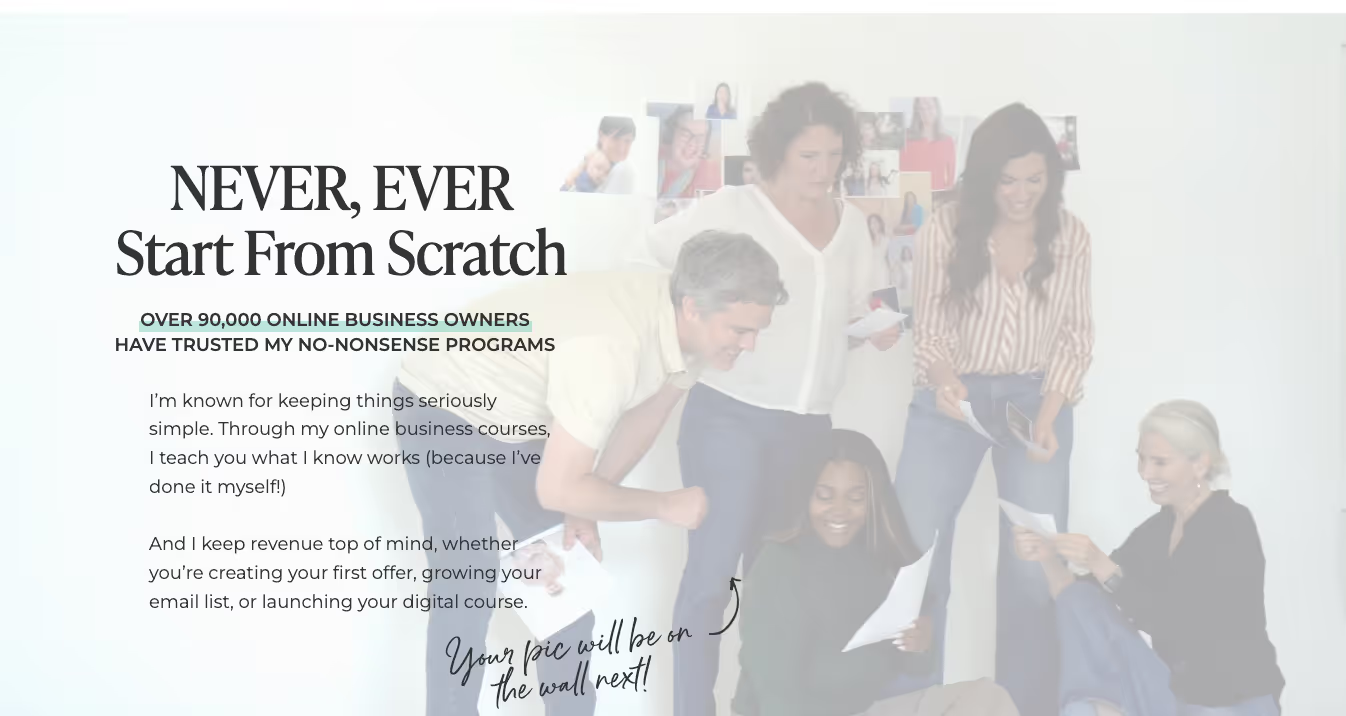
Key Elements:
- Benefit-Oriented Headline: “Create and Launch a Profitable Digital Course” clearly communicates the outcome.
- In-Depth Course Breakdown: Detailed descriptions of each module and lesson.
- Success Stories: Numerous testimonials and case studies from past students.
- Bonuses and Guarantees: Additional resources and a money-back guarantee reduce perceived risk.
- Multiple CTAs: “Enroll Now” buttons are strategically placed throughout the page.
Why It Works: The page provides extensive information and social proof, addressing potential concerns and building confidence in the course’s value.
4. Earnable by Ramit Sethi
Overview: Ramit Sethi’s "Earnable" course focuses on building profitable online businesses. The sales page uses storytelling and objection handling to build trust and credibility.
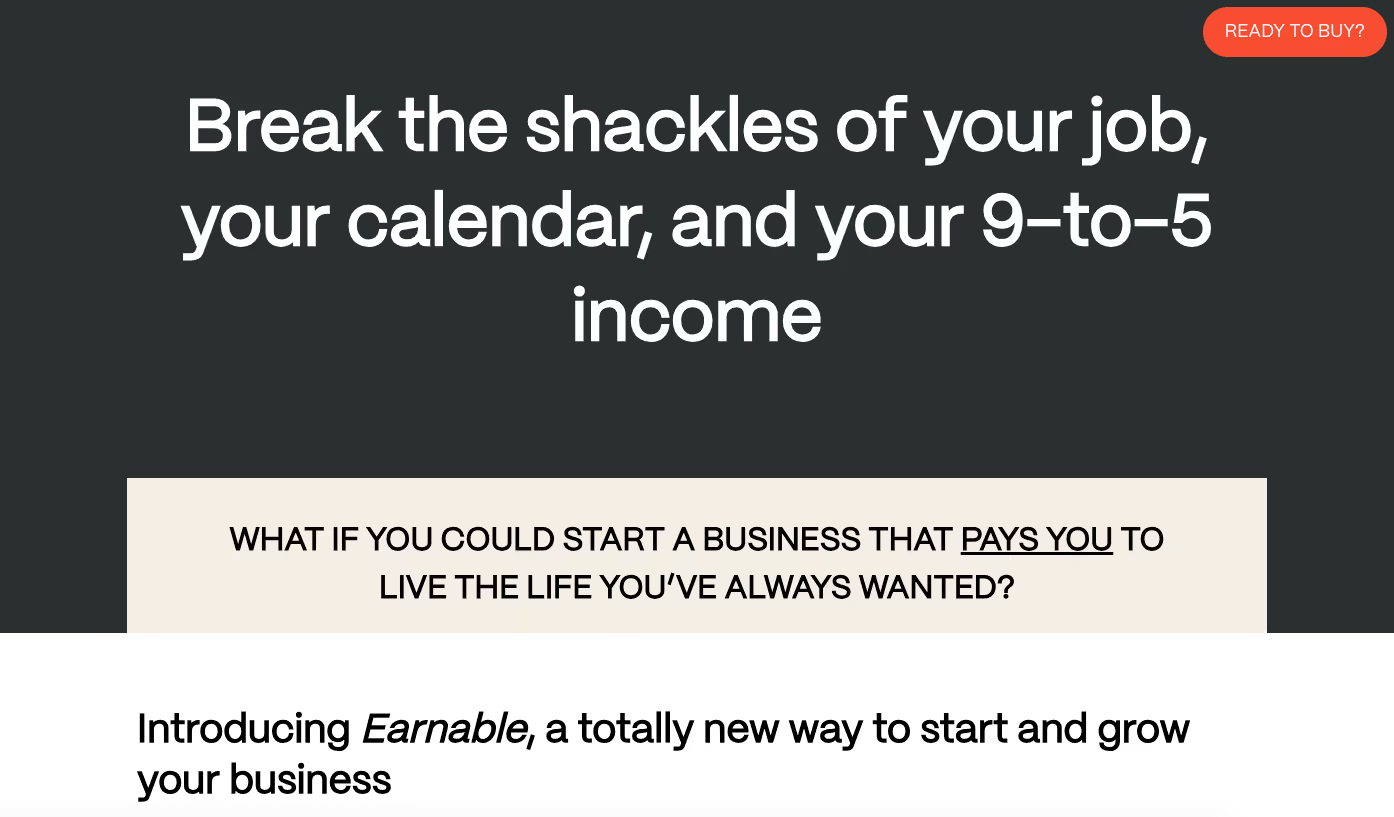
Key Elements:
- Relatable Headline: “Turn Your Skills into a Profitable Business” speaks directly to the target audience.
- Storytelling: Ramit shares his journey, creating a connection with readers.
- Detailed FAQs: Comprehensive answers to common questions and concerns.
- Transparent Pricing: Clear information on pricing and payment plans.
- Strong CTA: Prominent “Join Earnable” buttons encourage action.
Why It Works: The page builds trust through personal storytelling and transparency, effectively persuading visitors to enroll.
How EdisonOS Helps You Create High-Converting Sales Pages for Online Courses
EdisonOS specializes in course creation software that makes designing, customizing, and launching effective sales pages for your online courses easy. Here’s how our platform empowers you to create high-converting pages that showcase your courses and drive enrollments:
1. Easy-to-Use Sales Page Builder
Our intuitive sales page builder requires no coding skills, allowing you to set up a professional-looking page quickly. You can choose from optimized templates or start from scratch, creating a layout that highlights the unique value of your course.
- Drag-and-Drop Functionality: Customize elements easily with a drag-and-drop interface, making designing a high-quality sales page in minutes possible.
2. Customizable Content Sections for Maximum Engagement
EdisonOS offers customizable content blocks for structuring your sales page effectively. You can add sections that focus on different aspects of the course, such as descriptions, testimonials, instructor bios, and FAQs.
- Engaging Hero Section: Highlight your course’s main benefit with a bold headline, background images, or even introductory videos.
- Course Outline & Description: Break down the course content with bullet points, summaries, or expandable sections for easy reading.
- Instructor Bio: Add credibility with a dedicated section for instructor qualifications and background.
3. Built-In Social Proof Features
With EdisonOS, you can easily incorporate social proof, such as student testimonials and ratings, proven to build trust and improve conversion rates. You can add image-based testimonials, star ratings, and even short case studies of past student success.
- Testimonials and Reviews: Display genuine student feedback with our customizable testimonial sections.
- Case Studies: Highlight real-life success stories to show the impact of your course.
4. Strategic Calls-to-Action (CTAs)
Our platform provides customizable CTA buttons that are easily positioned throughout the sales page. EdisonOS lets you choose color schemes, add animations, and place CTAs in high-visibility areas to maximize clicks.
- Action-Oriented Text: Customize CTA text with phrases like “Enroll Now” or “Start Learning Today.”
- Eye-Catching Buttons: Select from various button styles to ensure your CTAs stand out and encourage visitors to act.
5. Optimized for Mobile and Desktop
EdisonOS ensures that all sales pages are fully responsive looking great on any device. With the rise in mobile learning, having a sales page that performs well on both desktop and mobile is key to capturing all potential students.
- Responsive Design: Pages automatically adapt to screen sizes, creating a seamless device experience.
- Mobile-Optimized CTAs: Large, easy-to-tap buttons ensure that mobile users have a smooth path to enrollment.
6. Advanced Analytics for Page Performance
Track your sales page’s performance with EdisonOS’s built-in analytics. See which sections engage users the most, monitor CTA clicks, and understand visitor behavior to optimize your page further.
- Visitor Metrics: Track how many people visit your sales page and their engagement levels.
- Conversion Tracking: See which CTAs convert best and adjust accordingly for maximum impact.
7. A/B Testing and Optimization
Test different versions of your sales page elements, such as headlines, CTAs, and testimonials, to determine what resonates best with your audience. A/B testing allows you to refine your page for optimal conversions.
- Test Headline Variations: Experiment with different messaging to find what drives the most engagement.
- Optimize for Higher Conversions: Use data-driven insights to make informed changes and improve overall performance.
With EdisonOS, you have all the tools needed to create a high-converting sales page that reflects the value of your online course, engages potential students, and simplifies the path to enrollment. Whether you want to launch your first course or scale an existing program, our platform is designed to help you succeed.

Recommended Reads
Recommended Reads

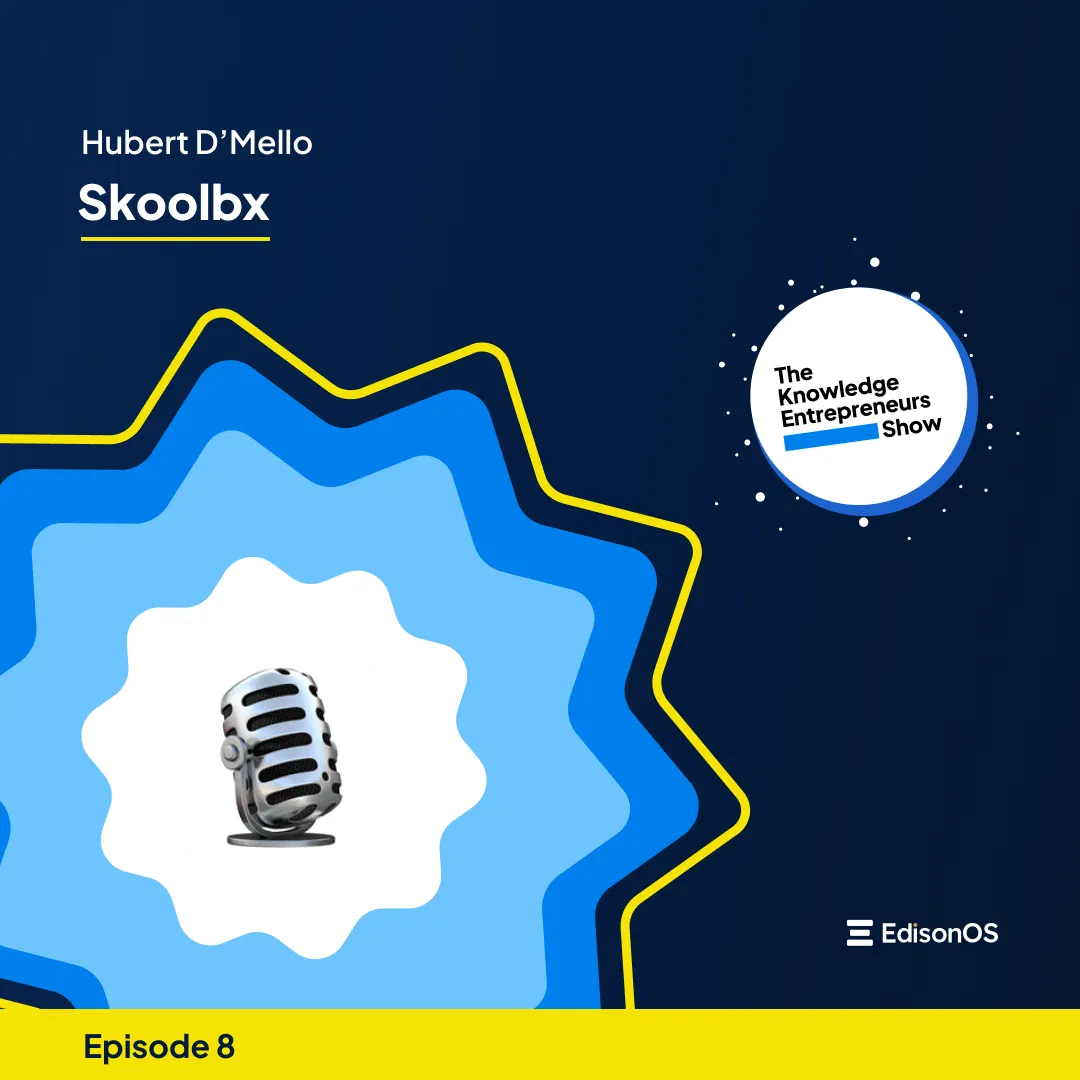









.png)
.webp)
